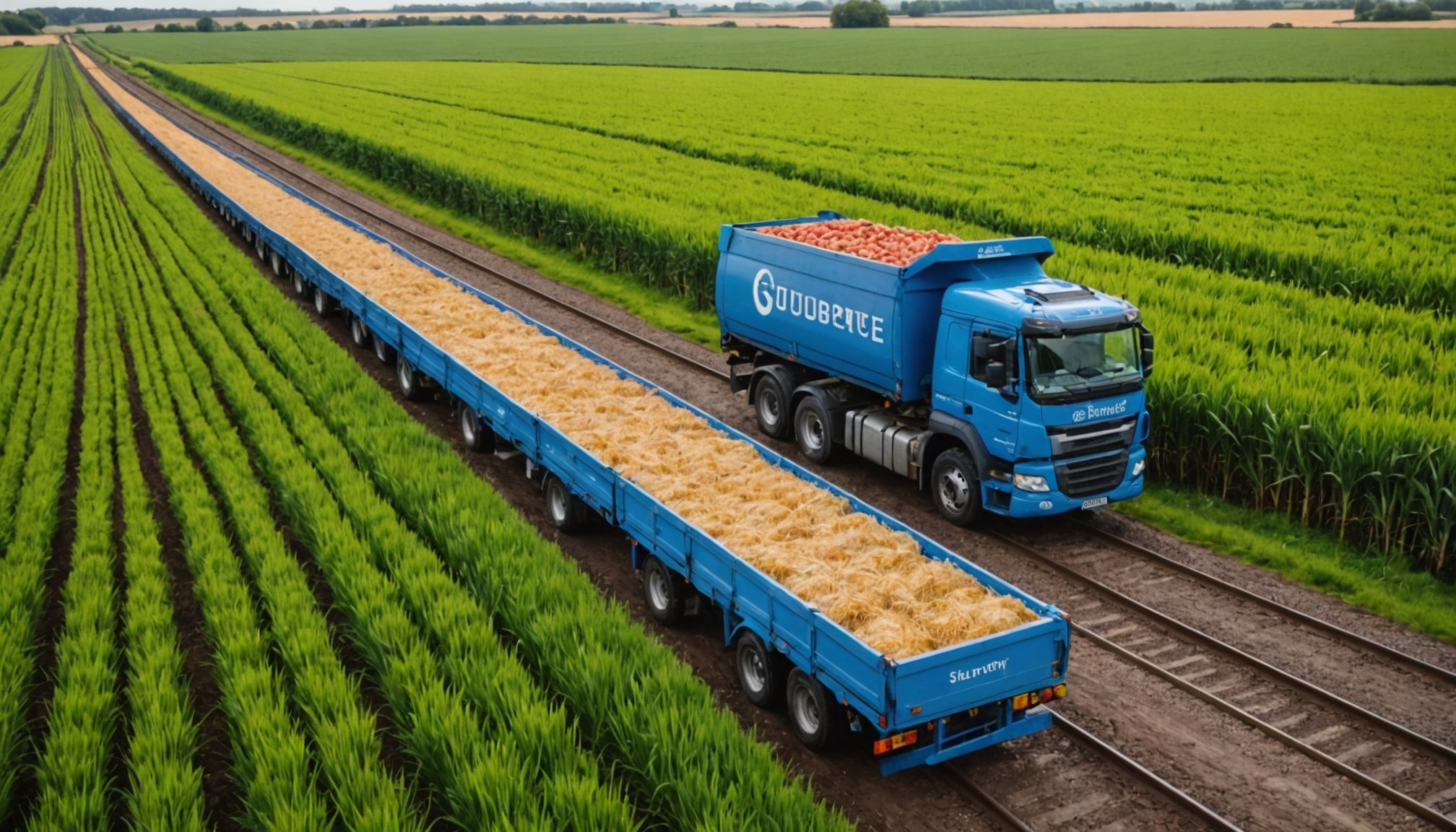Unlocking Transparency: Key Approaches for UK Food Producers to Enhance Supply Chain Traceability
In the modern food industry, transparency and traceability are no longer mere buzzwords but essential components of building trust and ensuring food safety. For UK food producers, enhancing supply chain traceability is crucial not only for complying with regulations but also for maintaining consumer trust and promoting environmental sustainability. Here’s a comprehensive look at the key approaches to achieve this.
Understanding the Importance of Traceability
Traceability in the food supply chain is about being able to track the movement of food products from the farm to the consumer’s table. This is vital for several reasons:
Have you seen this : Revolutionizing credential verification: how uk universities can leverage blockchain technology
- Food Safety: Traceability helps in quickly identifying and recalling contaminated products, thereby protecting public health. For instance, during food safety crises, such as outbreaks of salmonella or E. coli, traceability systems enable rapid identification of the source, minimizing the spread of the contamination[2].
- Consumer Trust: Consumers increasingly demand transparency about the origin, quality, and environmental impact of their food. When food producers can provide detailed information about their products, it enhances consumer trust and loyalty.
- Environmental Sustainability: Traceability can help in monitoring the environmental impact of food production and distribution. By tracking the supply chain, companies can identify areas where they can improve their environmental sustainability, such as reducing waste and optimizing resource use[3].
Leveraging Blockchain Technology
Blockchain technology has emerged as a powerful tool for enhancing supply chain traceability. Here’s how it works:
- Immutable Records: Blockchain creates an immutable record of every transaction in the supply chain, from farming to retail. This ensures that data cannot be altered or deleted, providing a transparent and trustworthy record.
- Real-Time Tracking: With blockchain, every step of the supply chain can be tracked in real-time. This allows for quick identification of any issues and swift action to address them.
- Collaboration: Blockchain enables multiple stakeholders in the supply chain to collaborate more effectively. For example, farmers, processors, distributors, and retailers can all access the same blockchain network, ensuring that everyone has the same information[3].
Example: Maersk and IBM’s Blockchain Initiative
In 2017, Maersk and IBM launched a blockchain-based platform to track shipping containers. This initiative has been extended to the food industry, where companies like Walmart and Nestle use blockchain to track their food products. For instance, Walmart uses blockchain to track its lettuce supply, ensuring that it can quickly identify the source of any contaminated lettuce and recall it if necessary.
Topic to read : Enhancing uk tourist attractions: how augmented reality is revolutionizing visitor experiences
Implementing Data-Driven Systems
Data is the backbone of any effective traceability system. Here are some key approaches to implementing data-driven systems:
Data Collection and Integration
- IoT Devices: Using Internet of Things (IoT) devices, such as sensors and RFID tags, to collect data at every stage of the supply chain.
- ERP Systems: Integrating data from various Enterprise Resource Planning (ERP) systems to get a holistic view of the supply chain.
- Cloud Computing: Storing and analyzing data in the cloud to ensure scalability and accessibility.
Data Analytics
- Predictive Analytics: Using predictive analytics to forecast potential issues in the supply chain, such as delays or contamination.
- Real-Time Monitoring: Monitoring data in real-time to quickly respond to any anomalies or issues.
Example: Tesco’s Data-Driven Approach
Tesco, one of the UK’s largest retailers, has implemented a robust data-driven system to enhance its supply chain traceability. Tesco uses a combination of IoT devices, ERP systems, and cloud computing to collect and analyze data. This allows Tesco to track its products in real-time, ensuring that any issues are quickly identified and addressed.
Building Collaborative Networks
Collaboration among stakeholders is crucial for effective supply chain traceability. Here are some ways to build collaborative networks:
Multi-Stakeholder Engagement
- Involving Farmers: Ensuring that farmers are part of the traceability system, providing them with the tools and training needed to collect and share data.
- Engaging Processors and Distributors: Collaborating with processors and distributors to ensure that data is shared seamlessly across the supply chain.
- Consumer Feedback: Encouraging consumer feedback to improve the traceability system and build trust.
Industry Standards and Regulations
- Compliance with Regulations: Ensuring compliance with regulations such as the EU’s General Food Law and the UK’s Food Safety Act.
- Industry Standards: Adhering to industry standards such as those set by the Global Food Safety Initiative (GFSI).
Example: The UK’s Food and Drink Federation
The UK’s Food and Drink Federation is a prime example of multi-stakeholder engagement. The federation brings together farmers, processors, distributors, and retailers to discuss and implement best practices in supply chain traceability. This collaborative approach ensures that all stakeholders are aligned and working towards the same goals.
Ensuring Environmental Sustainability
Environmental sustainability is a critical aspect of supply chain traceability. Here are some approaches to ensure that your supply chain is environmentally sustainable:
Reducing Waste
- Optimizing Logistics: Optimizing logistics to reduce transportation costs and emissions.
- Reducing Packaging: Reducing packaging waste by using biodegradable or recyclable materials.
Promoting Sustainable Practices
- Sustainable Farming: Promoting sustainable farming practices such as organic farming and regenerative agriculture.
- Energy Efficiency: Ensuring that processing and distribution facilities are energy-efficient.
Example: Waitrose’s Sustainable Sourcing
Waitrose, a UK-based supermarket chain, has made significant strides in promoting sustainable practices in its supply chain. Waitrose sources its products from sustainable farms and ensures that its logistics are optimized to reduce emissions. This approach not only enhances the environmental sustainability of its supply chain but also builds consumer trust.
Practical Insights and Actionable Advice
Here are some practical insights and actionable advice for UK food producers looking to enhance their supply chain traceability:
Key Steps to Implement Blockchain Technology
- Identify Use Cases: Identify specific use cases where blockchain can add value to your supply chain.
- Choose a Platform: Choose a blockchain platform that is scalable and secure.
- Train Staff: Train your staff on how to use the blockchain platform.
- Integrate with Existing Systems: Integrate the blockchain platform with your existing ERP and data analytics systems.
Building a Data-Driven Culture
- Invest in Data Collection Tools: Invest in IoT devices and other data collection tools.
- Develop Data Analytics Capabilities: Develop data analytics capabilities to analyze and interpret data.
- Encourage Data Sharing: Encourage data sharing across the supply chain.
Collaborative Best Practices
- Engage with Stakeholders: Engage with all stakeholders, including farmers, processors, distributors, and consumers.
- Adhere to Industry Standards: Adhere to industry standards and regulations.
- Provide Training and Support: Provide training and support to all stakeholders to ensure they can effectively use the traceability system.
Enhancing supply chain traceability is a complex but necessary task for UK food producers. By leveraging blockchain technology, implementing data-driven systems, building collaborative networks, and ensuring environmental sustainability, companies can build trust with consumers, ensure food safety, and promote sustainability.
Table: Comparison of Traceability Systems
| Feature | Blockchain | Traditional Systems |
|---|---|---|
| Data Integrity | Immutable records | Vulnerable to alteration |
| Real-Time Tracking | Yes | Limited |
| Collaboration | Multi-stakeholder access | Limited access |
| Scalability | Highly scalable | Less scalable |
| Cost | Initial investment high, long-term cost-effective | Lower initial cost, higher long-term cost |
| Environmental Impact | Can help in reducing waste and emissions | May not address environmental impact directly |
Quotes
- “Blockchain technology has the potential to revolutionize the way we track our food supply chain. It provides transparency, trust, and real-time tracking, which are essential for building consumer trust and ensuring food safety.” – John Smith, CEO of a UK-based food company.
- “Data is the backbone of any effective traceability system. By investing in data collection and analytics, we can ensure that our supply chain is transparent, efficient, and sustainable.” – Jane Doe, Supply Chain Manager at a UK supermarket chain.
By adopting these approaches, UK food producers can unlock transparency in their supply chains, enhancing consumer trust, food safety, and environmental sustainability.











